Ladder Safety

- mounting or dismounting the ladder improperly;
- losing one's balance;
- failing to set up the ladder properly;
- over-reaching while on the ladder; and
- mis-stepping while climbing or descending.
Statistics Concerning Ladder Dangers
- According to the World Health Organization, the United States leads the world in ladder deaths. Each year, there are more than 164,000 emergency room-treated injuries and 300 deaths in the U.S. that are caused by falls from ladders.
- Most ladder deaths are from falls of 10 feet or less.
- Falls from ladders are the leading cause of deaths on construction sites.
- Over the past decade, the number of people who have died from falls from ladders has tripled.
- Falls from ladders are the leading cause of ladder-related injuries, followed by using a ladder improperly, using a faulty or defective ladder, and simple carelessness.
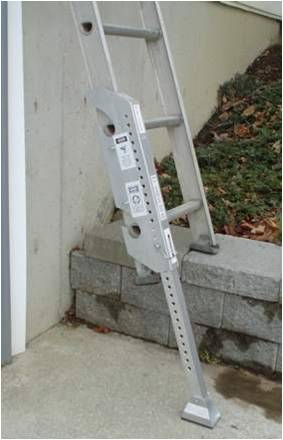
- a step ladder, which is a self-supporting ladder that is not adjustable in length, with a hinged design for ease of storage;
- a single ladder, which is a non-self-supporting ladder that is not adjustable in length, consisting of one section. This type of ladder is rarely used anymore because extension ladders are used instead;
- an extension ladder, which is a non-self-supporting ladder that is adjustable in length. It consists of two or more sections that travel in guides or brackets arranged so as to permit length adjustment;
- an articulated ladder, which has one or more pairs of locking articulated joints, which allow the ladder to be set up in several different configurations. It may be used as a step ladder or a single ladder;
- a tripod ladder, which has one leg opposite the rungs and is handy for applications where more support is desired than that provided by an extension ladder but where space to set up the ladder may be limited;
- a trestle ladder, which is a combination of a step ladder with a single extension ladder that can be raised through the top; and
- a telescoping ladder, which uses a pin system to "telescope" into variable lengths. As it is more portable than the extension ladder, it is often preferred over that design for indoor applications. Inspectors should be aware that accidents have happened due to failure of the pins, which can be difficult to detect in advance. Some inspectors refuse to use telescoping ladders for this reason.
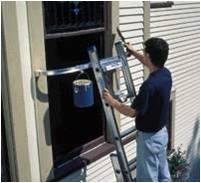
Accessories

Never:
- leave a raised ladder unattended. Ladders that are not in use should be laid on the ground or put away. A client may be tempted to climb the inspector's raised ladder if it is left unattended, which is never a good idea. Similarly, the inspector should never use the client's ladder;

- place a ladder in front of a door that is not locked, blocked or guarded;
- place a ladder on an unstable or uneven surface;
- use a ladder for any purpose other than the one for which it was designed. Many homeowners and even professionals sometimes use an extension ladder as a ramp between two points or as a shelf to hold materials and supplies, and what may seem convenient in a pinch in the field may lead to an accident or injury;
- tie or fasten ladders together to provide longer sections, unless they are specifically designed for that purpose;
- use a ladder in windy conditions;
- use a ladder if you're not fully alert and physically able;
- skip any rungs while climbing or descending;
- bounce on any rungs;
- use a ladder that has been exposed to fire or strong chemicals, as these conditions may leave residual damage or corrosion, which cannot be detected during use;
- exceed the maximum load rating. The maximum load rating, which should be found on a highly visible label on the ladder, is the maximum intended load that the ladder is designed to carry. Duty ratings are Type lll, ll, l, lA and 1B, which correspond to maximum load capacities of 220, 225, 250, 300 and 350 pounds, respectively. Inspectors and homeowners should know the duty rating of the ladder they are using, as well as the combined weight of themselves and their tools;
- use a step ladder in the closed or partially closed position, or use it by leaning it against a wall;
- sit on any rung, including the top;
- climb past the fourth rung from the top on a leaning ladder, or the second rung from the top on a step ladder. Never use the top step;
- pull, lean, stretch, or make any sudden moves. Over-reaching is the most common and dangerous form of ladder misuse;
- climb a ladder while holding tools or other items. Both hands are required for safe climbing and descent;
- pull or push any items while ascending or descending. Always wait until you're at the top or bottom of your working point to hoist or lower items;
- step on the rear section of a step ladder or the underside of an extension ladder;
- paint a wooden ladder, as this can conceal cracks and other damage that would require repairing or replacing the ladder; or
- drop or throw a ladder, or allow it to fall, which can create a hazard for others, as well as damage the ladder.
Before mounting a ladder, always check the following:
- that the ladder, steps and rungs are free of oil, grease, wet paint, and other slipping hazards;
- that the feet work properly and have slip-resistant pads. These pads become worn over time and may need to be replaced. On extension ladders, the rubber pads can be turned around to reveal metal spurs, which can be used to secure the ladder in soft surfaces, such as grass or dirt;
- that rung locks and spreader braces are working;
- that all moveable parts operate freely without binding or excessive play;
- that all bolts and rivets are secure;
- that ropes aren't frayed or excessively worn;
- that the ground under the ladder is level and firm. Large, flat, wooden boards braced under the ladder can level a ladder on uneven or soft ground. Also, some companies make leveling devices so that ladders can be used on uneven and hilly terrain;
- that the ladder's rungs, cleats or steps are parallel, level, and uniformly spaced when the ladder is in position for use. Rungs should be spaced between
 10 and 14 inches apart;
10 and 14 inches apart; - that the ladder is anchored. The base can be tied to a nearby sturdy object, such as a pole or a building. If no anchor is available, a stake can be driven into the ground. Inspectors should beware not to anchor their ladders to something that can impale them if they were to fall on it, such as a grounding rod. A 10-inch nail, hammered so as to leave only an inch or two exposed, is usually safe and effective;
- that the area around the ladder is roped off or barricaded. An "InterNACHI Inspector at work!" stop sign can also be placed beside the ladder to warn others to stay clear;
- for any cracks, bends, splits or corrosion;
- the location of nearby power lines. If setting up a ladder near them or other types of electrical equipment is unavoidable, use a wooden or fiberglass ladder rather than a metal ladder, which can conduct electricity and lead to a shock or electrocution. Do not allow your ladder to make contact with any overhead wires, regardless of the type or whether they're live, as it is not always possible to confirm their status;
- the distance of non-self-supporting ladders from the structure. This type of ladder must lean against a wall or other support, so they should be positioned at such an angle that the horizontal distance from the top support to the foot of the ladder is about one-quarter or a 4:1 angle of the working length of the ladder. A rough method to test this angle is by placing your toes at the base of the ladder and stretching your arm at shoulder height. Your hand should just touch the ladder;
- that the ladder has slip-resistant feet;
- that the ladder is the proper length for the job. Ladders should extend a minimum of 3 feet over the roofline or working surface;
- the locking devices. Step ladders must have a metal spreader or locking device to hold the front and back sections in an open position when in use; and
- that someone knows where you are. Accidents can and do happen in remote areas where cell phones are ineffective and no one is home. If you are injured under these conditions, no one will know you are hurt and need help.
While on the ladder, always:
- face the ladder;
- wear secure-fitting footwear free of mud and other substances that may cause you to slip;
- consider anchoring the top of the ladder with a bungee cord. Perhaps the most feared move an inspector must make is stepping back onto the ladder from the roof. They must step around the section of the ladder that extends above the roofline, placing lateral pressure on the rung as they make contact with the ladder. A bungee cord is a convenient tool that can be used to reduce any wavering that could otherwise result in a serious accident. Also, a bungee cord may prevent the ladder from being blown over in the wind while the inspector is on the roof;
- be conscious of the ladder's location, especially while walking on the roof. In an emergency, the inspector may need to leave the roof quickly. Ladders become much more dangerous when an inspector becomes covered in a swarm of stinging bees and must get down in a hurry, for instance;
- use a fall-arrest system for working at great heights or while performing complicated tasks;
- use the proper protective equipment for the job, such as a hardhat or eye protection;
- keep your body centered between the rails at all times. Do not lean too far to the side while working; and
utilize at least three points of contact, because this minimizes the chances of slipping and falling from the ladder. At all times during ascent or descent, the climber must face the ladder and have two hands and one foot, or two feet and one hand, in contact with the ladder cleats and/or side rails. In this way, the climber is unlikely to become unstable if one limb slips during the climb. It is important to note that the climber must not carry any objects in either hand that can interfere with a firm grip on the ladder.
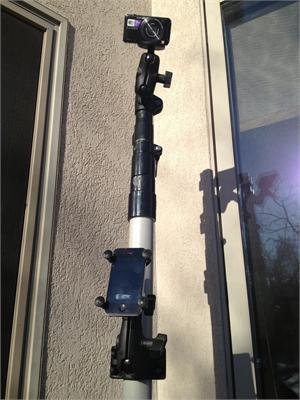
Inspector Outlet's Spectoscope integrates with your smartphone to take digital images.
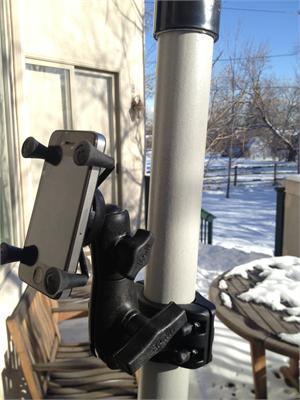
Inspector Outlet's Spectoscope allows you to
view the digital camera images above on your smartphone below.
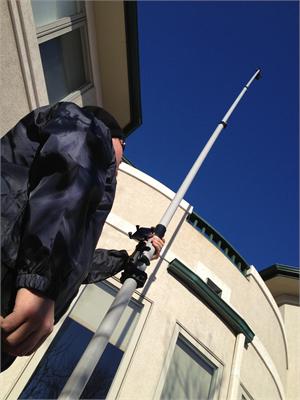
The Spectoscope mounts on 6-foot sections so that you can customize its height up to 28 feet.


